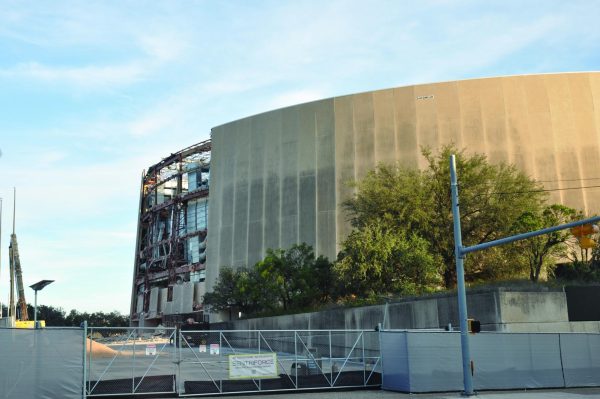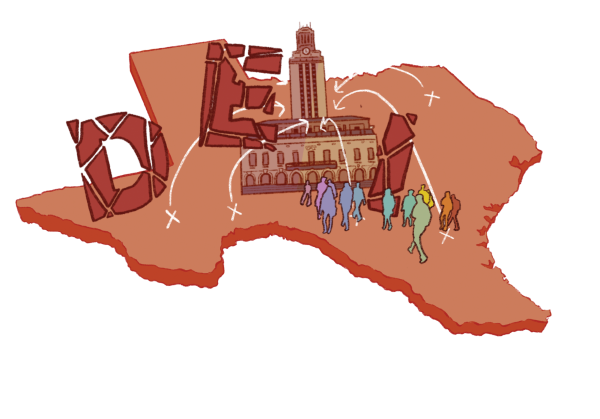LASA on the move
May 6, 2017
It’s official: the prospect of a LASA move was approved by the Austin Independent School District (AISD) Board of Trustees on April 3. The 6-2-1 vote permits the LASA move to proceed to bond planning, the next step to the relocation actually occurring, as well as providing official district approval of the move in concept. Even the concept of the move has proven controversial, however, with many LASA parents, community members and prospective parents facing down some East Austinites, equity activists and LBJ Science Academy (SA) alumni in and out of board meetings. Despite the vote, the move isn’t a sure thing yet, and with a still- undecided destination for LASA and a tight AISD budget, the waters around the move seem very murky indeed.
The prospect of a LASA relocation off the LBJ campus to a more central site is not new. It’s been discussed for over a decade, and was at one point the primary plan for the two schools following their official split in 2007. However, the present iteration of the movement to move began two years ago when development of AISD’s facility master plan began. The plan spans 20+ years, 130 facilities, and (it was hoped) several bonds to pay for all the planned improvements. LASA’s relocation was originally tapped for the first bond, meaning a move could occur in as little as five years. However, the hefty price tag of renovating or building a new high school, estimated to be over $100 million, has led recent bond planning efforts in the direction of phasing— packaging land preparation on the first bond, academic facilities on the second and so on— to create more realistic overall bond prices.
While the logistics remain complex, the principles behind the move are still highly controversial. LASA parent and Campus Advisory Council co-chair Ann Phipps said that a move would aid both LASA and LBJ.
“If LBJ is ever to be able to grow and thrive and serve as the kind of terrific neighborhood high school that AISD has several of, it needs bubble room,” Phipps said. “LASA, similarly, in order to grow and thrive, needs to be a place where students come to do what they do at LASA, and have the facilities in order to make that happen.”
The LASA and LBJ Campus Advisory Councils (CAC) have both passed resolutions in favor of a LASA relocation to a more central area. Phipps said that a move would provide both LASA and LBJ with increased freedom— for LASA it would increase accessibility to students from around the city and reduce lengthy commute times, and up capacity by 500 students. LASA has been pressed for space and forced to utilize numerous portables and increase class sizes at its current location, and increased independent physical space could allow better facilities and offer more students opportunities to use them.
“LASA could be more centrally located and have more students from across the district,” Phipps said. “Certainly we would have purpose-built facilities for things our students want to do and can’t accomplish. But just as important, the LBJ students would have room to take advantage of the state grant for advanced healthcare studies that they have, and would likely have room for additional services on campus.”
Phipps said a physical split could also aid LBJ. The early college high school has plans for a health science academy program involving turning part of the campus into a fully functioning medical clinic. The first phase of construction on this project begins this summer, and LASA Principal Stacia Crescenzi said a LASA move may be needed for LBJ to fully implement this program, as extra space is needed to construct a clinic in. Therefore, Crescenzi said a move would permit both schools increased freedom and resources.
“For LASA it would give us the opportunity to accept more students and therefore increase our diversity naturally,” Crescenzi said. “I think that the other benefit in general, although it’s not for LASA, is for LBJ to be able to grow, in total population but also programmatically, the way they’d like to. I think it allows both schools to make decisions and goals that are the best for their individual students, instead of the constant compromise which naturally happens when you’re working together every day.”
However, drawbacks have been pointed out. Many East Austin advocates have posited that the move goes against principles of diversity and integration. Both the Liberal Arts Academy (LAA) and the SA, which later combined to form LASA, were originally founded in part as a desegregation initiative. AISD District 1 Trustee Dr. Ted Gordon therefore said he views a LASA move away from LBJ as a betrayal of its mission and a failure of desegregation. Gordon’s constituency includes the LBJ area in northeast Austin. As one of the two trustees to vote against LASA’s move, he said the move was a cop-out on the part of the district.
“The district has refused to face the problems that LASA and LBJ have, because they are complex,” Gordon said. “And now, rather than facing up to these problems between the two schools, the solution now is to give up and say alright, let’s separate. Unfortunately, it’s going to cost a lot of money to do that; second of all, it’s going to violate, I think, some of [AISD’s] basic principles; and third of all it’s not going to happen right now and so you can’t run away from it.”
Opposition has also come from LASA and SA alumni, who have emphasized the colocation with LBJ as an integral part of their academic experiences. SA alumnus and LBJ 1990 class president Sam Turner said that LASA’s proposed move is symbolic of the resegregation of America, and took away from the magnet’s educational value.
“There’s no permutation of this that’s in the best interest of the students,” Turner said. “My class and the classes around us valued so much the idea of the combined education and combined student body. It was a different thing than any other school. It breaks our heart that you guys and the future generations aren’t going to get it.”
Ironically, one of the main reasons LASA is looking to move is to increase representation within the student body. Crescenzi said that the increase in physical space that a move could bring would increase the racial and economic diversity of the school.
“It would absolutely allow us to create the campus culture that we want, so that we could really help people to understand that we welcome everybody who’s interested to apply, and everybody who we accept to join us,” Crescenzi said. “Some of the students who we’re telling no now, we won’t be telling no. And I’m hoping some of those things, just in and of themselves, will increase the economic and racial diversity of the campus, and… the diversity of student interests on campus.”
This move is divisive even on the LASA/LBJ campus (see pages 8-9.) In a survey of 132 LASA and 8 LBJ students, around 57 percent of students supported a LASA move, while half that number (28 percent) supported keeping LASA on the LBJ campus. A tenth of students were undecided, and four percent advocated another option. LASA junior Marcella Cannati said in a response to the survey that she supported a LASA move.
“I think it’s important that both schools be given the space they need to grow to their full potential,” Cannati said. “Sharing such a small campus can create a lot of hurt feelings where one school feels like it’s missing out because of the existence of the other school on their campus. I can think of quite a few times when I have felt frustrated because I felt like LBJ was getting more than LASA was in one way or another, which I think is normal when we are being forced to share everything.”
Despite concerns from alumni and others that a LASA move would directly hurt the district’s desegregation goals Phipps also emphasized the dual purposes of the SA that became LASA, which was founded in the 1980s as both a desegregation initiative and as an appeal to business communities looking for more STEM-savvy Austinites to employ.
“The Liberal Arts and Science Academies, separate programs, founded in the [1980s] to be a mechanism for desegregation, are not what we’re talking about,” Phipps said. “Now we have students from all parts of town, it’s a diverse student body… a lot of kids who want an advanced academic program. We can do that anywhere.”









